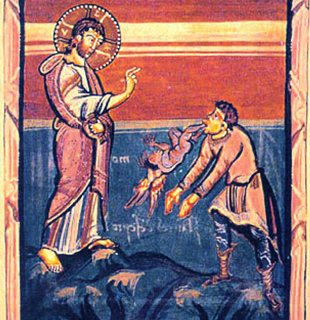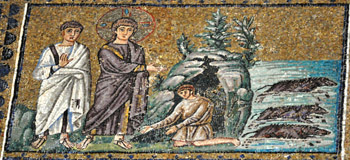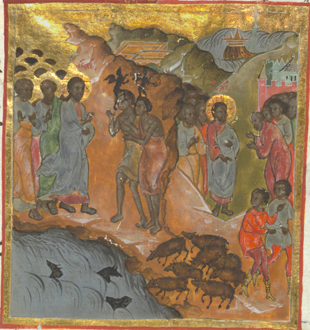For Sunday June 23, 2019
Lectionary Readings (Revised Common Lectionary, Year C)
Readings:
1 Kings 19:1-4, (5-7), 8-15a
Psalms 42 and 43
Galatians 3:23-29
Luke 8:26-39
He haunts the places of the dead. Every night, the townspeople hear him, shrieking among the tombs. When they're quick enough, they catch him, wrap his wrists and ankles in chains, and haul his naked body — securely shackled — back to town. But there’s no containing the crazy; he escapes each time. Trailing broken chains behind him, he wanders the wilds, tearing at his skin until it bleeds, trading one kind of pain for another. If he has a name, no one knows it. If he has a history, no one remembers it. If he has a soul worth saving inside his living corpse, no one sees it. No one looks.
Until Jesus does.
The story of the “Gerasene demoniac” is a tough one for us 21st century Christians to enter into, because it’s full of details we find bizarre. Chatty demons? Suicidal swine? Instantaneous healing? Isn’t this the stuff of black comedy? Or horror? How is an ancient exorcism story “Good News” for us?
I know that much ink has been spilt in recent decades, trying to address what contemporary Christians find anachronistic and troubling about this story: Was the man really possessed by demons, or "just" mentally ill? Isn’t there a danger involved in conflating acute psychological suffering with evil? If the demons were real, why did Jesus negotiate with them? Why did he even show them mercy? And what about those poor pigs?! Why did they have to die to secure the demoniac’s healing? Didn’t Jesus care about them? Or about the economic welfare of the pig-herding townspeople who watched in horror as their livelihood disappeared over a cliff?
These are valuable questions, and I don’t mean to dismiss them. But I worry that focusing on the stranger parts of the story prevents us from seeing how it can be our story, a story of our here and now. So indulge me, please, as I sidestep the tough stuff, and share why I’m haunted (in good and necessary ways) by the healing of the Gerasene demoniac. Why his encounter with Jesus makes me gasp and squirm, smile and cry, linger and recoil, repent and return.
 |
First, I think the story is our story because it begins precisely where we ourselves need to begin, and that is with a question. “What is your name?” Jesus asks when he first encounters the possessed man by the lake. Remember, the man approaches Jesus, NOT to ask for help, but to push Jesus away. Maybe to scare Jesus away. In all likelihood, his approach is violent and feral. But Jesus asks for a name, anyway, and by doing so, he begins to recall the broken man to himself. To his humanity, to his beginnings. To his unique and precious identity as a child beloved of God.
What is your name? Has there ever been a more loving, searching question? What would happen if you allowed Jesus to ask it of you? What would happen if you asked it of others? Who are you? Who are you, really? Beneath the labels and the diagnoses, the pretense and the piety, the fear and the shame? Who are you when no one in this world is looking? What name do you yearn to be called in the lonely stretches of the night? Who were you before you lost yourself? Before something vital in you died? Do you even remember?
Jesus begins where we must begin. With an honest questioning and naming of ourselves. Can we allow him to search us so deeply? Can we hear him asking the tender and intolerable question: What is your name?
Second, I believe the story is our story because it tells us the unflinching truth about our condition. “Legion,” the man says in response to Jesus’s question. My name is Legion. A multitude. A vast host. An incalculable swarm. Why? Because (Luke’s Gospel tells us) “many demons” torment him. In other words, the sources of his brokenness are myriad. The assault on his mind, soul, and body is multi-pronged; it comes from many sources braided together.
Perhaps it doesn’t matter how we choose to explain these “demons.” Regardless of what language we use (Biblical, theological, medical, sociological), what we know for sure is that the man’s condition strips him of agency, sanity, dignity, and community. It keeps him in isolation. It renders him anonymous. It encourages him to mutilate his own body. It deadens his soul and divides his mind. In short, it deprives him of self-control, and propels him towards self-destruction.
Does any of this sound familiar? The truth is, what ails us as human beings is Legion. The evil that haunts us has many faces, many names. We are all — every one of us — vulnerable to forces that seek to take us over, to bind our mouths, to take away our true names, and to separate us from God and from each other.
 |
Some of us suffer from depression or anxiety. Some of us are addicted to sex, alcohol, wealth, or thinness. Some of us experience the world at a deafening volume, in colors too lurid for our sensitive eyes. Some of us are slaves to the internet, or prone to bitterness, or caught up in cycles of dishonesty, or in lust with our own rightness. Some of us can’t shake traumatic memories. Some of us were abused as children. Some of us are seething with jealousy. Some of us are imprisoned within systems of injustice that stretch back so many centuries, we can’t imagine liberation. Some of us experience our skin colors, our accents, our genders, or our sexualities as magnets for other people's hatred. Some of us suffer illnesses that criss-cross the boundaries of medicine and culture, nature and nurture. Some of us know exactly what St. Paul is talking about when he says, “What I want to do I do not do, but what I hate I do.”
If we expand the definition of “possession” to include everything that conspires to keep us dead when God wants us alive, then the story of the Gerasene demoniac is not an ancient oddity. It is the air we breathe. The zeitgeist we inhabit. It is the pandemic of our time.
That’s the bad news. But it’s not where the story ends. The third reason I consider the story “our story” is because it tells us exactly where salvation lies, and it does so without hesitation or apology. When the demoniac sees Jesus, he falls down before him. When the townspeople come running to see what’s going on, they find the man “sitting at the feet of Jesus, clothed and in his right mind.” Salvation, in other words, lies at the feet of Jesus. It lies in surrendering to the one who alone has the power to cast out the horrors which torment us. This is not because Jesus is an arrogant megalomaniac. It’s because evil in all of it incarnations finds him terrifying. It’s because there is no death-dealing power in this universe that can withstand the saving, healing, resurrecting power of Jesus. It’s because even the most destructive demons we can conjure up beg for mercy when he comes to town.
But is this the story we offer to the “possessed” who walk through our doors each Sunday? Is it a story we even believe anymore? Or has the long haul of this thing we call Christianity, with its stretches of unanswered prayer, its unhealed diseases, its too-frequent grinds of grief, loss, doubt, and boredom — worn out our souls and watered down our claims?
The problem is, we have an eschatology that is glorious but incomplete. We live, as it were, on Holy Saturday. We live in the uncomfortable tension between the already-and-the-not-yet. Yes, Jesus has already defeated death. Yes, the demons already fear his name. Yes, we are right to look to God for the healing and liberation the Gospels attest to so faithfully. But no, the battle is not yet over. No, the abyss hasn’t yet swallowed the demons whole. No, the complete freedom we seek is not yet within our grasp.
But that doesn’t mean the story is false. It means we have unspeakably more to look forward to. It means our hope is grounded in what Jesus has already done, in the power he has already demonstrated. It means we have every reason to share the Good News with confidence now.
 |
If only we could stop there. But Luke goes one step further in his Gospel account of the Gerasene demoniac, so we must, too. The fourth reason to embrace this story as our own is because it illustrates an unpleasant truth about human relationships. When the townspeople see that the demon-possessed man is healed, they don’t rejoice. They express no relief, no gratitude, no hospitality, no awe. Instead, they recoil in fear, and beg Jesus to go away.
What does this mean? Maybe it means we humans prefer to stick with demons we know, rather than embrace freedoms we don’t. Maybe it means we need some people to be “bad” so that we can be good. Maybe it means the shackles and chains that bind so many of God’s children are the instruments of our own cruel making, the weapons we wield to manage our own fears. Maybe it means we settle for tolerance instead of challenging ourselves to love. Maybe it means the Gospel doesn’t always bring peace — it also brings upheaval, messing with our moral categories, economic comforts, and social structures in ways we find offensive. Maybe it means resurrection sometimes comes along and kicks our butts so hard we ask Jesus to leave us alone — because we’d so much rather stay dead.
The story ends with Jesus commissioning the healed man to stay where he is and serve as the first missionary to his townspeople — the same townspeople who feared, shunned, trapped, and shackled him for years. I have to admit, this detail makes me laugh, albeit ruefully. Isn’t this just like Jesus? To choose the very people we consider the most unholy, the most unredeemable, the most repulsive and unworthy — and commission them to teach us the Gospel? THAT is God all over.
Here, then, is a story about our truest names. Here is a story about resistance and resurrection. Here is a story about the Jesus who finds us naked among the tombs, clothes us with dignity, scatters the demons to save our souls, and turns us into storytellers who will help heal the world. Here is OUR story. Amen.
Debie Thomas: debie.thomas1@gmail.com
Image credits: (1) Wikipedia.org; (2) ChristianIconography.info; and (3) Vanderbilt Divinity Library.





